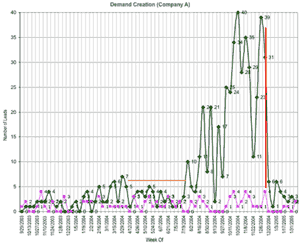Thursday, May 18, 2006
The Rise and Fall of a Demand Creation Strategy: A Case Study
Marketers know a successful demand creation strategy requires a commitment not only financially but of support from senior management. Unfortunately, while the benefits of an integrated, multi-channel demand creation strategy for a business are enormous, building an opportunity pipeline typically takes more time than many companies have the stamina for. I’ve enjoyed seeing challenging lead generation work pay off and I’ve also been on the receiving end when a short-sighted management team pulled the plug. Many times I wished I had some data on hand as ammunition for discussions with the CEO when the future of the plan (and business!) was on the line. The following case study tracks the lead growth of Company A, a healthcare sales & marketing services company, over the course of two years with business-to-business prospects. It demonstrates how continuous support and funding of a demand-creation strategy builds momentum over time while a cut-off of support quickly and dramatically erodes growth gains.
In the Beginning
The chart shows that it takes some time to sort out the right marketing channel mix and build momentum. During this phase many resources were put into building awareness along with targeted initiatives to seed a long-term pipeline. Over the course of 1 year, a multi-channel integrated demand creation strategy increased lead volume from an average of 3 to 20 leads per week. At the same time, unqualified leads (magenta trend line) were reduced and qualified leads (green trend line) rose from 57.5% to 89.8% of all leads.
Still, particularly in the early stages, momentum is fragile. The yellow bar shows the effect on lead generation of halting journal advertising and reducing multi-channel initiatives for 4 months due to sudden budget cutbacks. When all available demand creation channels in the integrated plan were restored, lead generation rebounded and grew exponentially.
The Great Crash
Unfortunately, despite the high volume of qualified leads turned over to business development, an opportunity pipeline of over $US 60 million for the year and a visibility of 2-3 years on future prospects for lead nurturing, senior management ended support and funding of resources for the integrated plan in mid-December (red line). The dropoff was more catastrophic than I could ever have predicted. With a decimated lead pipeline and stock price that ultimately lost more than 55% of its value, two years later the company still struggles to recapture what was lost. It is a cautionary tale worth sharing with management: cut marketing at your own peril.
Note: This post is a portion of an expanded article I’m preparing on marketing momentum. If you’d like to be notified when it is available for download contact me.
Source: Internal Study Sept 2003 – Feb 2005


